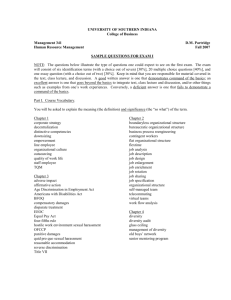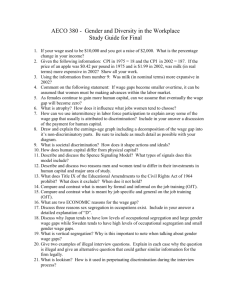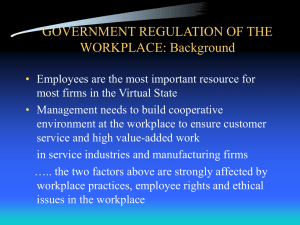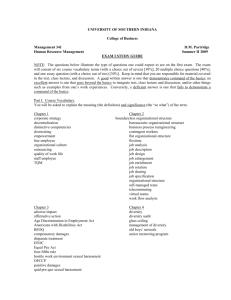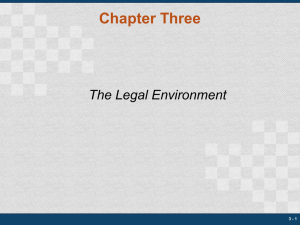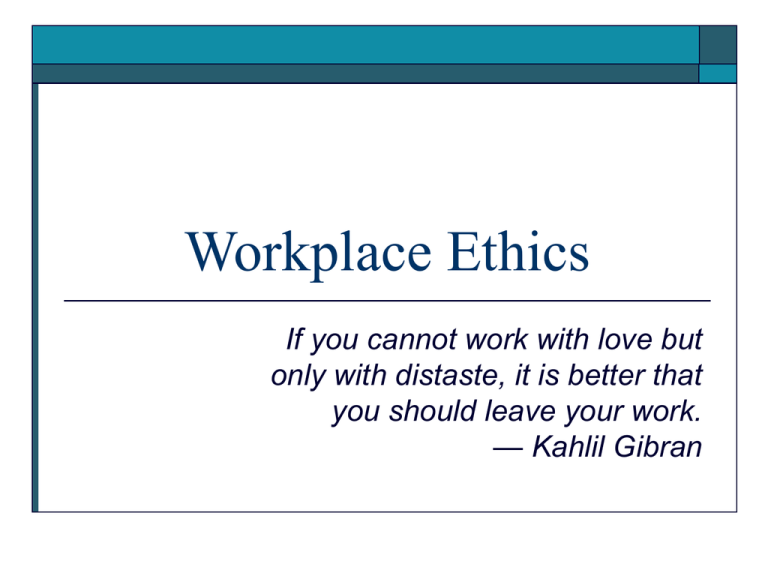
Workplace Ethics
If you cannot work with love but
only with distaste, it is better that
you should leave your work.
— Kahlil Gibran
Overview: Workplace Ethics Issues
The meanings of work
Wage-labor contract vs. a more explicitly ethical
view
Minimum wage and “living wage”
Compensation and benefits
Occupational safety and health
Equal employment opportunity
Sexual harassment
Substance use and abuse on the job, theft, sabotage,
workplace violence, and privacy
Why do people work?
Income for survival and life style support.
Opportunities to learn and grow.
Social connectedness and a sense of belonging.
Personal identity: “I am a machinist/waitress/manager.”
Opportunities to be and to feel useful.
Status, prestige.
Pleasurable and rewarding “flow” experiences.
Power and independence.
A feeling that we are following our mission or calling.
Anything else?
Other benefits of work:
Work keeps us healthier.
Ciulla: Work “offers instant discipline,
identity, and worth. It structures our time and
imposes a rhythm on our lives. It gets us
organized into various kinds of communities
and social groups. And perhaps most
important, work tells us what to do every
day.”
How We View Work:
Wage-labor contract: employees are free to
choose their jobs & trade their skills and labor
for wages. Market demand for and supply of
labor determines prevailing wage rates.
Ethical view: work has intrinsic worth and
offers what people need to live a life of
respect and dignity.
Minimum Wage
2.5% of American wage-earners are at or
below minimum wage. (NOT including 8
million farm workers and transient day-labor)
26% of these are teens; 27% are very young
adults; 47% are aged 25 or older.
Minimum Wage
Most minimum wage jobs are part-time with
no benefits.
Most have no career track.
Little training, few or no ‘development’
opportunities.
Living Wage: What Does It Take to
Live a Decent Life?
Add it up:
Rent & utilities
Car
Food
Clothes & shoes
Phone
Cable TV, DSL
Medical/dental
Pets
Tuition & books
Entertainment
Other?
Are You Making Ends Meet?
If so, congratulations! How do you do it?
Share housing
Eat ramen noodles
Walk/ride bike/bum rides from friends
Drink less (no) beer
Lose the pet(s)
On credit (college loans, credit cards….)
Parents help out/fullscholarship
Work many hours a week; lose sleep, cut classes.
The Working Poor in America
The working poor are those who spent at least
27 weeks in the labor force—working or
looking for work—but whose incomes fell
below the official poverty level.
Of all persons who worked 27 weeks or more,
5.3 percent were classified among the
working poor in 2002, up by 0.4 percentage
point from the previous year.
SOURCE: “A Profile of the Working Poor, 2002,” U.S. Department of Labor, Bureau of Labor
Statistics, Sept. 2004, Report 976 http://www.bls.gov/cps/cpswp2002.pdf
Working Poor, continued
nearly 2 in 3 of the working poor who worked
during 2002 usually worked full time.
about 71 percent of the working poor were white .
Blacks and Hispanics are twice as likely to be among
the working poor as are whites and Asians.
6 percent of women, vs. 4.7 percent of men, are
among the working poor.
9.0 percent of 16- to 19-year-olds and 10.2 percent
of 20- to 24-year-olds were in poverty.
SOURCE: “A Profile of the Working Poor, 2002,” U.S. Department of Labor, Bureau of Labor Statistics,
Sept. 2004, Report 976 http://www.bls.gov/cps/cpswp2002.pdf
Working Poor, continued
Nearly 4.0 million families with at least one member
in the labor force for 27 weeks or more—6.3 percent
of all such families—lived below the poverty level in
2002. This was up from 5.9 percent of families in the
previous year.
Of the 29.8 million unrelated individuals who were
in the labor force for 27 weeks or more in 2002, 8.7
percent lived below the poverty level. This was up
from 8.1 percent in 2001.
SOURCE: “A Profile of the Working Poor, 2002,” U.S. Department of Labor, Bureau of Labor Statistics,
Sept. 2004, Report 976 http://www.bls.gov/cps/cpswp2002.pdf
Poverty in the U.S.
2003 HHS Poverty Guidelines
Size of Family Unit 48 ContiguousStates and D.C.
1
$ 8,980
2
$12,120
3
$15,260
4
$18,400
5
$21,540
SOURCE:
Federal Register, Vol. 68, No. 26, February 7, 2003, pp. 6456-6458.
Let’s Translate That….
$8,980 for an individual living alone (not counting
college students in dorms, homeless people, or other
‘uncountables’)
Divide by 12 months: $748 per month gross.
Average work week of 35 hours yields $4.93 per
hour, so…
the average workweek must actually be less than 35
hours, if earning minimum wage.
SOURCE: “A Profile of the Working Poor, 2002,” U.S. Department of Labor, Bureau of Labor Statistics,
Sept. 2004, Report 976 http://www.bls.gov/cps/cpswp2002.pdf
“Living Wage”
Advocates propose a minimum wage that would
assure a dignified life for individuals and families.
The working poor must use public welfare programs
– food stamps, Medicaid, Section 8 housing, free
emergency care for the indigent, homeless shelters,
heating oil and electricity subsidies – just to survive.
When subsidized employers are allowed to pay their
workers less than a living wage, tax payers end up
footing a double bill.
Wages Abroad
“Prevailing wages” are often too little to allow
workers to arise from poverty.
World Bank estimates: more than one billion
people live on a dollar a day or less – extreme
poverty.
Many of these people are working to make the
sweats, jeans, & shoes we wear, the toys we
play with, the electronics we love.
Mark Twain on Wage Work
There are wise people who talk ever so knowingly
and complacently about "the working classes," and
satisfy themselves that a day's hard intellectual work
is very much harder than a day's hard manual toil,
and is entitled to much bigger pay…. [A]s far as I
am concerned, there isn't money enough in the
universe to hire me to swing a pickaxe thirty days,
but I will do the hardest kind of intellectual work for
just as near nothing as you can cipher it down – and
I will be satisfied, too….
– A Connecticut Yankee in King Arthur's Court
U.S.-Mandated Benefits
Social Security tax of 6.2% (another 6.2% is paid by
the employee) of wages or salary, up to $94,200.
Medicare tax of 1.45% (another 1.45% is paid by the
employee, on all wages or salary.
Unemployment insurance, with rates varying by
state.
Workers’ compensation insurance, also varying by
state.
ONLY for full-time workers; some industries and
small businesses exempt.
Common Voluntary Benefits
paid vacation
holidays and sick days
health, life, dental, and
vision insurance
contributory and noncontributory retirement
plans
charitable gifts
matching programs
daycare
dependent care &
medical spending
accounts
tuition reimbursements
travel, clothing, and
equipment allowances
stock grants or options
flex-time
Workplace Safety and Health
OSHA founded 1971; necessary to raise
quality of life in workplaces.
Sick/injured workers less expensive
sometimes than making a workplace safe.
Health/safety issues are incredibly diverse and
often very complex.
Equal Employment Opportunity
The Civil Rights Act of 1964 - centerpiece of
efforts to end discrimination in employment
(Title VII) and education (Title IX), extending
protections on the basis of race, color, religion
or creed, national origin, and sex.
The Equal Employment Opportunity
Commission (EEOC) was established by this
Act and founded in 1965, with 100 employees
and an initial budget of $2.5 million.
The Equal Pay Act of 1963, requiring employers to pay men
and women the same wages for essentially the same work.
Executive Order 11246, issued by President Johnson in 1965,
established “affirmative action” as a valid mechanism to
correct for the unjust effects of past discrimination.
The Age Discrimination in Employment Act, passed in 1967,
prohibiting practices such as firing older workers because
they are more expensive than younger workers.
The Rehabilitation Act of 1973 forbade employment
discrimination in the federal government against persons with
disabilities.
Weber v. Kaiser Aluminum and Chemicals, 1976: The
Supreme Court upheld the legality of Kaiser’s affirmative
action plan, approved by management and the union, which
reserved 50 percent of training spots for unskilled black
workers regardless of seniority. Kaiser, a white employee,
was judged not to be the victim of “reverse discrimination”
because the court held that Kaiser’s set-asides were
temporary protections for an underrepresented group.
Bakke v. University of California, 1978: This famous case
upheld the use of race as a criterion in admissions to medical
schools, as long as it was not the sole factor in the decision.
EEOC issued guidelines for voluntary corporate affirmative
action plans in 1979. The plans were mandatory, however, for
federal contractors.
The Americans with Disabilities Act of 1990
prohibited employment discrimination against
qualified persons with disabilities in private industry
as well as in federal, state, and local governments.
The Civil Rights Act of 1991 allowed compensatory
and punitive damages to successful plaintiffs and
made jury trials available in cases of intentional
discrimination, thereby increasing employers’
chances of losing big, because juries are more likely
than judges to award damages to plaintiffs.
Affirmative Action
Controversial, but initially straightforward:
Developed to help restore groups that had
historically been discriminated against to a
position where equal opportunity was
possible.
Meant to correct for the effects of past
discrimination.
Affirmative action plans are not quotas; they are
plans for trying to improve the number of women
and minorities in jobs, training programs, and
promotion tracks.
These plans require that qualified minorities and
women be given preference in hiring and promotion
until established goals are met, to correct for the
effects of past discrimination and continuing
prejudice.
Hiring or promoting an unqualified person is
contrary to affirmative action and serves only to
retard the progress of employment equity.
Nevertheless, some employers faced with
regulatory compliance demands may settle for
a “quick fix” by hiring or promoting an
unqualified minority or woman candidate, just
to fill a “quota” or to show efforts to be
nondiscriminatory.
Some may even do so to sabotage the whole
affirmative action effort, trying to create a
kind of “see, I told you so” backlash.
As of EEOC’s 2003 data, 6.5 percent of the
4,543,489 “officials and managers,” a Census
Bureau category, are black, and 35.2 percent
are women (only 3.2 percent are black
women).
In 1990, about 5 percent were black and 20
percent were women, and these figures
represented very substantial increases over
earlier decades.
Improvements largely exist in lower- and
middle-level management positions.
Among the 2006 Fortune 500 companies,
only ten had women CEOs: Reynolds
American, Avon Products, Xerox, Safeco,
Lucent Technologies, Rite Aid, Golden West
Financial, Radio Shack, Sara Lee, and eBay.
Franklin Raines became the first black
Fortune 500 CEO (of Fannie Mae) in 1998.
Sexual Harassment
AstraZeneca pharmaceuticals, 1996:
CEO Lars Bildman was under suspension and
investigation for allegedly maintaining a corporate
culture in which women employees were routinely
fondled, required to go to bars and strip clubs with
male managers, made the butt of sexual jokes, and
exposed to hard-core pornography plastered all over
the home offices.
Ultimately the CEO was fired, numerous civil suits
were settled out of court, and the company merged
with another and restructured.
Sexual harassment is NOT about sexual
attraction – it is about power the harasser
wishes to exert over the victim.
Employees have a right to be free of uninvited
and unwanted sexual incidents on the job.
Most large organizations have clear-cut
policies and training programs to help their
employees avoid sexual harassment problems
How EEOC views sexual harassment:
The victim as well as the harasser may be a woman
or a man. The victim does not have to be of the
opposite sex.
The harasser can be the victim's supervisor, an agent
of the employer, a supervisor in another area, a coworker, or a non-employee.
The victim does not have to be the person harassed
but could be anyone affected by the offensive
conduct.
Unlawful sexual harassment may occur without
economic injury to or discharge of the victim.
The harasser's conduct must be unwelcome.
Other Workplace Issues
substance use and abuse on the job
theft
sabotage
workplace violence
privacy concerns (drug testing, medical and
employment records, health conditions,
personal life circumstances or events)
Conclusion
Work is so vital to human beings that societies in the
developed world all have a large number of specific,
legal protections to ensure that workers’ rights are
not violated.
It is easy for company executives to lose sight of the
fact that their employees are human beings with
inherent rights to dignity and respect and with civil
and legal rights to be free from discrimination and
harassment, undue hazards, violence, and violations
of privacy.
This is why so many essential ethical protections for
workers are built into law and public policy.

